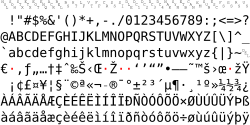 | |
| MIME / IANA | windows-1252[1] |
|---|---|
| Alias(es) | cp1252 (code page 1252) |
| Language(s) | All supported by ISO/IEC 8859-1 plus full support for French and Finnish and ligature forms for English; e.g. Danish (except for a rare exceptional letter), Irish, Italian, Norwegian, Portuguese, Spanish, Swedish, German (missing uppercase ẞ), Icelandic, Faroese, Luxembourgish, Albanian, Estonian, Swahili, Tswana, Catalan, Basque, Occitan, Rotokas, Toki Pona, Lojban, Romansh, Dutch (except the IJ/ij character, substituted by IJ/ij or ÿ), and Slovene (except the č character, substituted by ç). |
| Created by | Microsoft |
| Standard | WHATWG Encoding Standard |
| Classification | extended ASCII, Windows-125x |
| Extends | ISO 8859-1 (excluding C1 controls) |
| Transforms / Encodes | ISO 8859-15 |
| Succeeded by | Unicode (UTF-8, UTF-16) |
Windows-1252 or CP-1252 (Windows code page 1252) is a legacy single-byte character encoding[2] that is used by default (as the "ANSI code page") in Microsoft Windows throughout the Americas, Western Europe, Oceania, and much of Africa.[3]
Initially the same as ISO 8859-1, it began to diverge starting in Windows 2.0 by adding additional characters in the 0x80 to 0x9F (hex) range (the ISO standards reserve this range for C1 control codes). Notable additional characters include curly quotation marks and all printable characters from ISO 8859-15.
It is the most-used single-byte character encoding in the world. Although almost all websites now use the multi-byte character encoding UTF-8, as of July 2024 1.2%[4] of websites declared ISO 8859-1 which is treated as Windows-1252 by all modern browsers (as demanded by the HTML5 standard[5]), plus 0.3% declared Windows-1252 directly,[4][6] for a total of 1.5%. Some countries or languages show a higher usage than the global average, in 2024 Brazil according to website use, use is at 3.4%,[7] and in Germany at 2.7%.[8][9] (these are the sums of ISO-8859-1 and CP-1252 declarations).
- ^ Character Sets, Internet Assigned Numbers Authority (IANA), 2018-12-12
- ^ "Encoding. Living Standard". WHATWG. 13 June 2024. § 9. Legacy single-byte encodings. Retrieved 2024-06-28.
- ^ Karl-Bridge-Microsoft (2021-10-26). "Code Pages - Win32 apps". learn.microsoft.com. Retrieved 2024-10-09.
- ^ a b "Historical trends in the usage statistics of character encodings for websites, December 2023". w3techs.com. Retrieved 2024-07-19.
- ^ Cite error: The named reference
WHATWGwas invoked but never defined (see the help page). - ^ "Frequenty Asked Questions". w3techs.com.
- ^ "Distribution of Character Encodings among websites that use Brazil". W3Techs. Archived from the original on 4 April 2024. Retrieved 2024-07-19.
- ^ "Distribution of Character Encodings among websites that use .de". W3Techs. Archived from the original on 4 April 2024. Retrieved 2024-07-19.
- ^ "Distribution of Character Encodings among websites that use German". w3techs.com. Retrieved 2023-01-16.